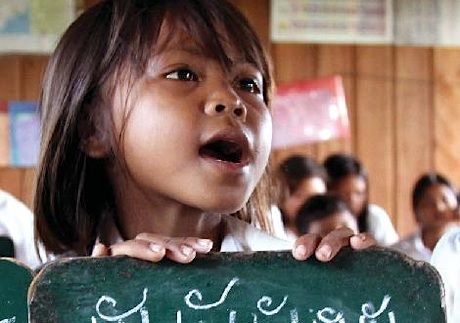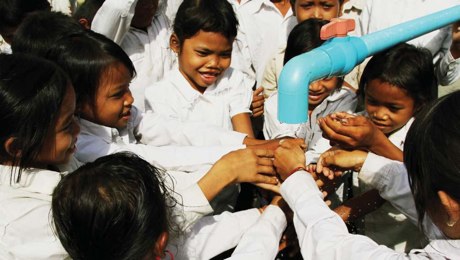Project Report
On 20 February 2010, through the funds generated by the Footprints Network, Oxfam Australia and its local partners finished building a new primary school in Tial village, Stung Treng province, Cambodia. The new school includes a three-room schoolhouse, a house for the teachers, toilets, a 5,000-litre water tank, a flagpole and a school gate. The school is fully equipped with tables, chairs and blackboards and is a comfortable, safe place to learn.
Families living in Tial village can now send their children to primary school, with around 100 students regularly attending in grades one to five. Students are much more enthusiastic about going to school and they can continue to attend school through the rainy periods — an impossibility in the last school, which was made of thatch and leaves.
The new school is solidly built with concrete foundations, timber and bamboo walls and a fibrous cement roof.
Mr Pann Sotheary, a schoolteacher at one of the Oxfam supported schools in Stung Treng district, has noticed many benefits resulting from the new school buildings.“Students study more quickly now because we have a good classroom,” he says. “I have installed poems, pictures, maps and other samples for students to look at and gain interest. These resources make learning easier for some students.” “Now students want to continue studying at high school and their parents also want their children to continue studying.
Last year, I selected three students to continue studying at high school.”Tial village plans to introduce after-school activities such as vegetable growing, sports activities and drawing contests. These will not only broaden the students’ education but also make it more fun to learn.
Quality teaching
In remote, rural communities in Cambodia, it can be hard to recruit and retain teachers due to the poor working and living conditions offered by communities. To attract a teacher to the Tial village school, Oxfam Australia built a house for the teachers.
The house helps to reduce the teachers’ financial costs, and means they can stay in the village for the full school year. With more privacy and better working and living conditions, the teachers are also more likely to stay for the long term.Despite rice shortages, community members also provide 250 kilograms of rice per year to support the teachers. In other similar projects, this support has encouraged teachers to get involved in the wider community, improve the school’s facilities and strive for better teaching outcomes.“Students’ parents, villagers and I are very happy with the good school building because it is strong and students are more confident to study,” says schoolteacher Mr Sotheary. “I would like to thank Oxfam Australia for their support.”

(Image: Sorn is learning how to read and write at her new school. Achieving universal primary education is the second major target of the Millennium Development Goals.)
Better health
The new facilities at Tial village school, which include clean drinking water and toilets, are helping to reduce the outbreak of diseases such as diarrhea. Students are also being taught about the importance of sanitation and hygiene practices. It is hoped that the wider community will see the link between clean water and sanitation facilities in the new school and reduced outbreaks of disease and take a stronger interest in health and hygiene practices.

(Image: Students from Tial village school enjoy clean water from the new 5,000-litre water tank.)
Empowering women and girls
Women bear most of the burden of poverty in Cambodia so we are working to empower women and girls by providing them with equal access to education. When women are educated and able to exercise their rights, entire communities benefit from better nutrition, healthcare, education and reduced violence and exploitation. In this project, women actively participated in all stages of decision-making about the school’s construction and many helped to collect materials for the school’s foundations. Of all the adult literacy students, 60% are women. Nearly half the primary school students (48%) are girls.
Community support
Children who can’t get an education want to go to school more than anything else. Unfortunately, children in poor communities are often sent to work in the fields instead of being sent to school. The process of designing and implementing this project has helped raise community awareness about the importance of education and the benefits of maintaining the school in the future.
The project received strong support from local authorities, the provincial education department and local community, and good coordination with Oxfam staff meant that the construction process went smoothly, finished on time and within budget.
Meetings with villagers were very effective and led to villagers identifying their needs, contributing significant amounts of materials and labour and ultimately feeling ownership over the project.
Local authorities provided some funding for chalk and paper, the community built a flagpole and school gate of their own accord and regular monitoring during construction meant that the buildings were built to a high standard. The sense of ownership felt by the community has encouraged them to look after the school and develop more interest in the importance of education in reducing poverty. The school building is being used as a community resource. The space is used to run adult literacy classes, hold traditional celebrations and as a meeting place.
The small donations from thousands of people through the Footprints Network for the Stung Treng Schools project continues to help children living in poverty go to school and increase their opportunities for the future.

(Image: Soeum participates in question-and-answer time.)
What is next for this project?
In 2010–11, Oxfam Australia will build a primary school in Kompong Pang village, where there is currently no school. Some children travel to a neighbouring village to attend school, but they have to cross five rivers to get there. These rivers are impossible to cross during the rainy season, meaning children miss out on learning to read and write. Building a primary school in Kompong Pang village will be an important step forward for the community as they work to improve their future options.
This project will cover:
Implementation and monitoring the build of a 3-room school plus teacher's house, a set of solar-panels and water tank.
This project includes community involvement tasks such as:
- Mobilizing community to contribute their resources to the school building,
- Negotiating and mobilizing all government management departments and district governor in order to get timber for building schools and other facilities
- Preparing and organizing a bidding process in order to increase the accountability and increase the stakeholders participation and contribution
- Developing the agreement with all stakeholders such as community, local government, and contractor and construction materials suppliers.
Project Outcomes:
This project will promote education in a remote area where around 80% of children are not able to partake in the government-educational system.
Teachers will be dispatched to the villages by the provincial department of Education, Youth and Sports. This strategy encourages the Cambodian government to focus on remote areas lacking equal access to basic services, particularly education.
The building of teacher’s houses, with solar panels, is an important strategy to help retain teachers living in the village and provide a venue for adult education classes.
The community will also be encouraged to use school the as multi-purpose center for traditional and cultural purposes.
Project Background
Tial village is comprised of 493 people, including 255 women and 90 families. Villagers rely on rice growing, farming, hunting, logging and resin collection. Few families have cattle to help with farming and, in drought years, rice shortages are experienced for most of the year.
Tial primary school has only one room with a poorly thatched roof. At the moment the teachers have agreed with villagers to use the pagoda but there is insufficient space for students to study. Two male teachers work at the school and live in a community house with poor services. Community members gather rice as food to support the teachers and built a hut for teachers to stay and teaching students.
Part of a larger project
Oxfam has identified 3 small villages in remote regions that all require new and revitalised education facilities. It is a three year project that will see one school built in one village each year. Footprints funded the Pha Ao village school project 2008, and intends to support the final phase of the program in Kampong Pang (2010/11).
In total over the three years, there will be three wooden school buildings (9 rooms), 3 teacher’s houses, 3 water-tanks and three sets of solar panels.
Community Involvement
Community contribution is essential for the success of this project. The community will contribute some materials and labor. The community is responsible for monitoring of work quality of staff and government counterparts. The community will also be involved in the final evaluation and opening ceremony.
Oxfam Australia has been operating in Cambodia since 1982.